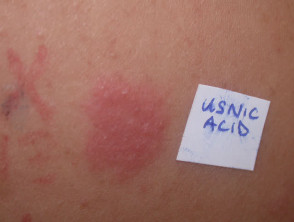| Common name: | Lichens |
| Botanical name: | There are over 15,000 lichen species, comprising 60 families with over 400 genera. |
| Family: | Alga + fungus |
| Origin: | Lichens are widely distributed from the tropics to the high arctic and from the sea shore to high altitudes |
| Description: | Lichens are dual organisms composed of a symbiotic relationship between an alga and a fungus. The fungus, usually an Ascomycete, provides the plant its shape, and the alga provides the ability to photosynthesis. This successful combination is able to produce a more elaborate and durable organism than either partner alone. Lichens are able to colonise inhospitable areas such as bare rock. As pioneer plants, lichens break down the rock surface and, together with decaying material from the lichen, eventually form soil conditions suitable for other plants. Many lichens are epiphytic (able to grow on trees), gaining nutrition from rain running down tree trunks. Only a few species tolerate air polluted with sulphur dioxide so few survive in cities. Lichens are variable in shape, either tubular, upright and branching, or flat and leaf-like or forming an amorphous greyish crust. |
| Uses: | Lichens are used as fodder, particularly the Reindeer lichens: Cladonia raniferina, C. alperstris and C. sylvatica. Other fodder species include Cetraria, Stereocaulon and Alectoria. Cetraria islandica has been made into bread, porridge or gruel for human consumption. Lichens have been used instead of hops for brewing beer and was the basis of a large Swedish brandy industry in the 19th Century; 10 kilograms of lichen yielding five litres of 50% alcohol. Lichen dyes were renown for their high quality and colour but have largely been replaced by synthetic aniline dyes. Litmus paper was originally manufactured by the Dutch from lichens. Since the 16th century, members of the families Cladoniaceae, Stictaceae, Parmeliaceae and Usneaceae have been used as raw materials in the perfume and cosmetic industries. As manufacturing techniques improved, lichen extracts have been combined into toilet powders and scented sachets. Today the principal species still used in perfumery are Evernia prunastri (Oak moss), E. furfuracea and several Ramalinae spp. |
| Allergens: | Usnic acid, atranorin, evernic acid |
| Allergy: | Allergic contact dermatitis. In 1907, a patient with crocodile hands (‘mains de crocodile’) from contact with the bark of chestnut trees was described. It was postulated that the lower order plants (lichens) growing on the trees might have been responsible for dermatitis. A report of a man who developed dermatitis on the side of his neck and ear after carrying freshly cut oak logs on his shoulder followed shortly. A similar case was reported from Italy where it was observed that the rash recurred on each time on returning to work with wood. Since this time there have been numerous reports of contact dermatitis from lichens growing on the bark of firs (Abies), larches (Larix) and chestnuts (Castanea). Most occupational contact dermatitis to lichens occurs in forestry workers who have contact with lichens growing on the bark of trees. The rash is usually confined to exposed skin surfaces but less obvious patterns can occur when lichens get inside an open shirt and lodge at the waist-line or when the clothes are saturated with rain. Usnic acid is insoluble in water but is carried down tree trunks by rainwater and is present in the soil until degradation occurs. Lichen sensitivity may also develop from non-occupational contact with wood, for example from carrying fire-wood at home or from contact with lichens whilst climbing a tree. Some ground lichens can also sensitise. A third of ‘lichen pickers’ who harvest Cladonia stellaris, used in Christmas decorations, flower arrangements, toy trees in model railway layouts, etc, suffer from allergic contact sensitisation. Other cases have been reported from arranging reindeer moss as a Christmas decoration. Today the main cause of contact dermatitis to lichens is through exposure to perfumes containing oakmoss. |
| Cross-reactions: | A number of patients are allergic to both lichens and liverworts. This probably represents multiple sensitisations, rather than cross-sensitisation, as both lichens and liverworts (Frullania) coexist on trees. The allergens in Frullania are sesquiterpene lactones which are probably not present in lichens. |
| Other information: | Theophrastus used the term Lichen (derived from the Greek leprous) to describe a superficial growth on the bark of olive trees. Initially, lichens also included the liverworts (Hepaticae), but Diocorides ascribed the term to true lichens on account of their resemblance to the cutaneous disease (presumably lichen planus) for which they were supposed to be specific. The medicinal use of lichens can be traced back to the 18th dynasty (1700-1800 BC) when Evernia furfuracea was first used as a drug. Herbal lore often used plants which looked like a disease to treat that disorder. Xanthoria parietine, being yellow, was supposed to cure jaundice, while Peltigera aphthosa, the thallus of which is dotted with small wart-like tubercles, was recommended for children who suffered from thrush. The long filaments of Usnea barbata were used to strengthen the hair, although Hippocrates prescribed it for uterine ailments. Boerhaven used Lobaria pulmonaria for haemorrhage and asthma. Other species of Evernia, Peltigera, Parmelia, Cladonia, Roccella and Pertusaria were used to control fevers, diarrhoea, infections, skin diseases, epilepsy, convulsions and as purgatives. The Maori of New Zealand dried and then reduced lichens or ‘Kohukohu’ to powders for application onto cutaneous eruptions. The active ingredient, like that of the Chinese drug ‘shi-hoa’ and the Japanese ‘seki-ka’, is usnic acid which is known to be antibacterial. |
| Patch test: | Lichen (specific plant) as is; 1% D-usnic acid; 1% Evernic acid; 0.5% Atranorin; 2% Oak moss; 1% stitic acid; 1% fumarprotocetraric acid |
Contact allergy to usnic acid
